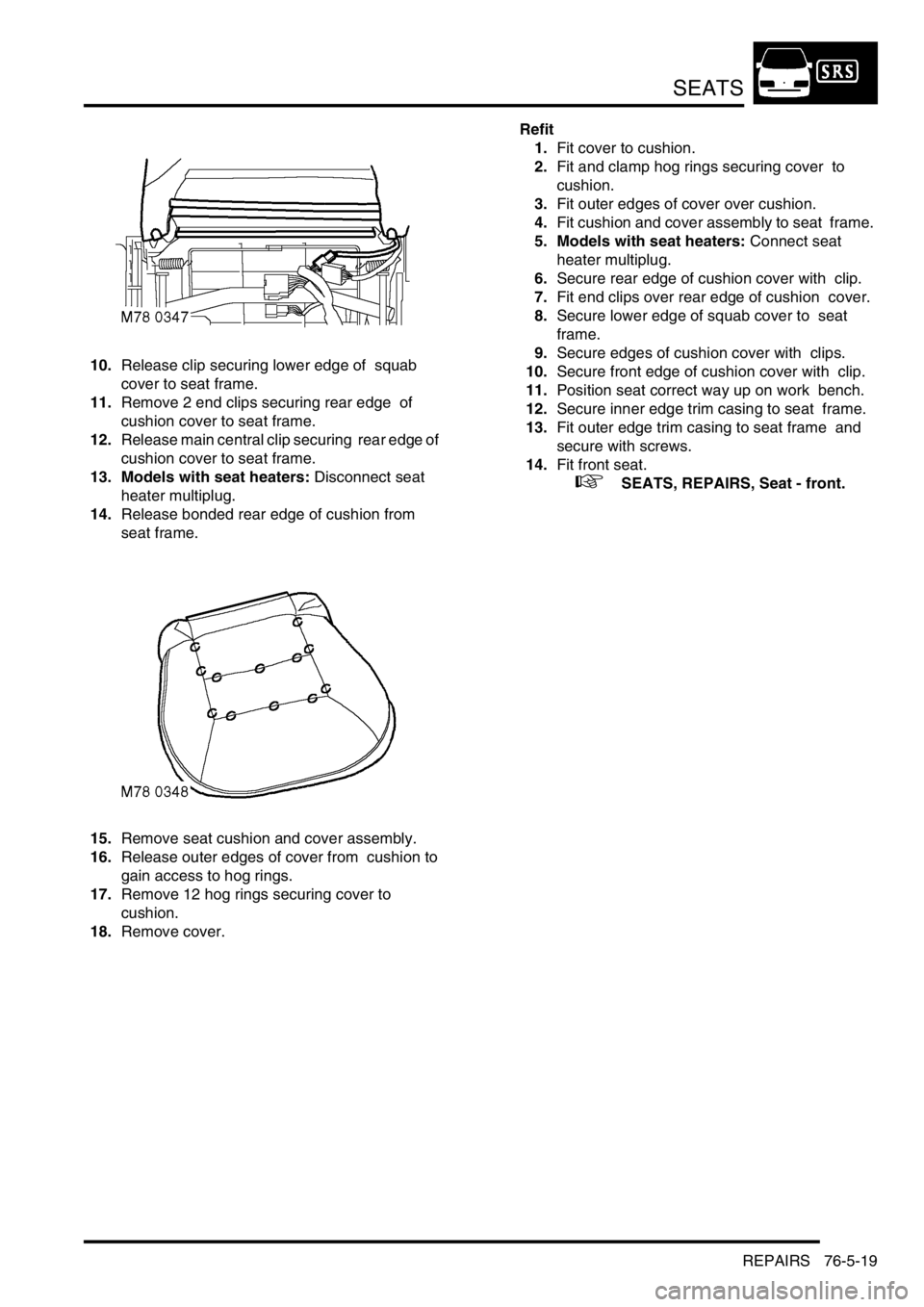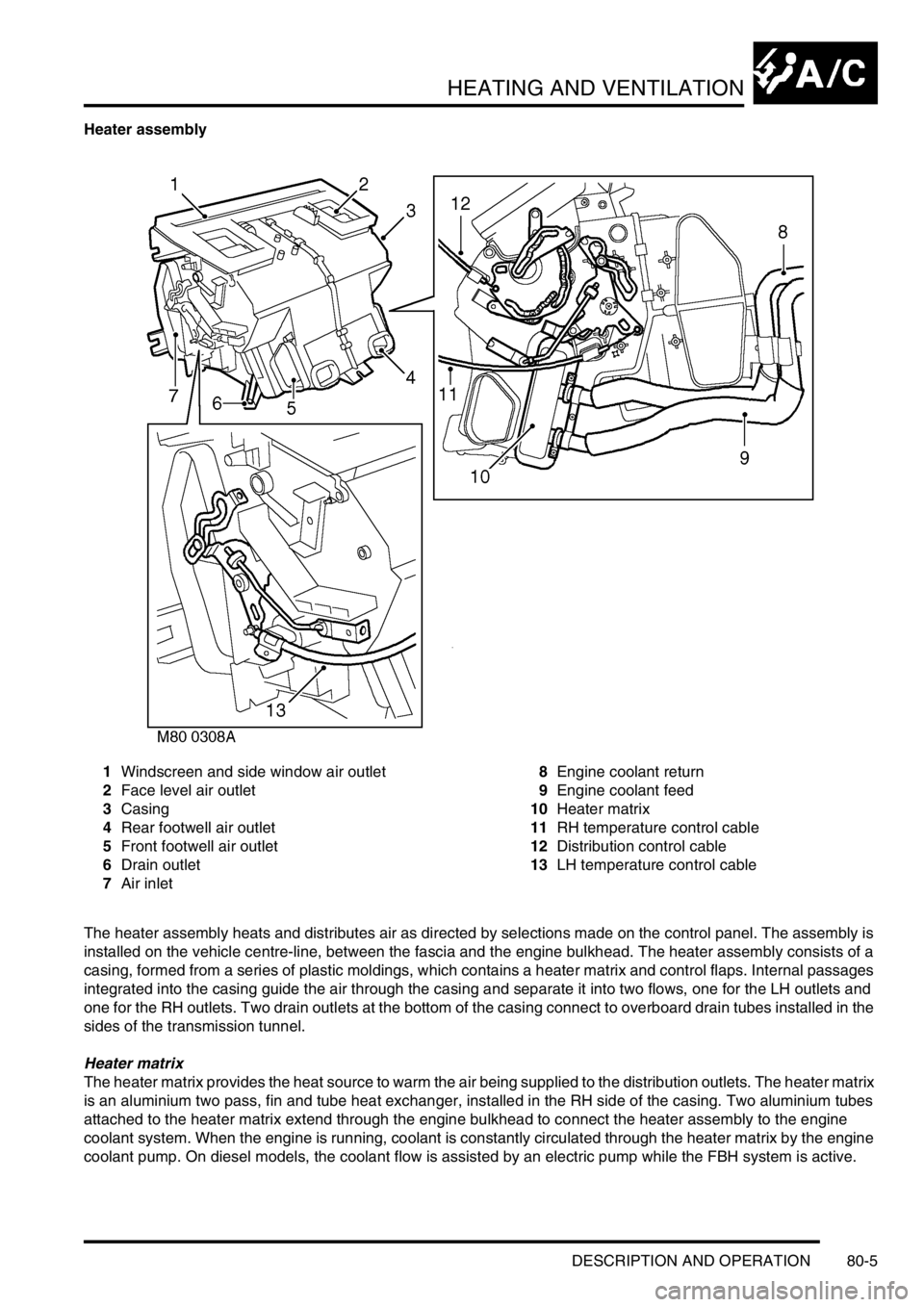Page 1197 of 1672
SEATS
76-5-12 DESCRIPTION AND OPERATION
Temperature control unit
The temperature control unit is only fitted to vehicles with electric seats. Feed back of the seat temperature is via a
Negative Temperature Coefficient (NTC) sensor within the seat cushion. Resistance of this sensor changes with the
temperature of the seat cushion allowing the temperature control unit to lower or raise the voltage to the seat heater
elements to raise or lower their temperature.
An ignition feed is supplied via the seat heater switch. The temperature sensor supplies an input. Output is a supply
to the cushion heater element and an earth.
Thermostat
On vehicles with non electric seats, the temperature is controlled by a thermostat located in the seat cushion. The
thermostat interrupts the power supply when it reaches a pre-determined temperature.
Page 1198 of 1672
SEATS
DESCRIPTION AND OPERATION 76-5-13
Operation - heated seats
When the seat heater switch is operated, power is supplied to the heater elements in the seat, causing the seat to
heat up. On vehicles fitted with non electric seats, the thermostat switches the power supply to the heater elements
on and off. On vehicles fitted with electric seats, the temperature control unit senses seat temperature via the sensor
in the cushion and regulates voltage to the seat heater elements to maintain a constant temperature.
On both electric and non electric seats, the heater elements increase and then maintain the seat at a temperature
between 26 and 36
°C (79 and 97 °F).
Page 1204 of 1672

SEATS
REPAIRS 76-5-19
10.Release clip securing lower edge of squab
cover to seat frame.
11.Remove 2 end clips securing rear edge of
cushion cover to seat frame.
12.Release main central clip securing rear edge of
cushion cover to seat frame.
13. Models with seat heaters: Disconnect seat
heater multiplug.
14.Release bonded rear edge of cushion from
seat frame.
15.Remove seat cushion and cover assembly.
16.Release outer edges of cover from cushion to
gain access to hog rings.
17.Remove 12 hog rings securing cover to
cushion.
18.Remove cover. Refit
1.Fit cover to cushion.
2.Fit and clamp hog rings securing cover to
cushion.
3.Fit outer edges of cover over cushion.
4.Fit cushion and cover assembly to seat frame.
5. Models with seat heaters: Connect seat
heater multiplug.
6.Secure rear edge of cushion cover with clip.
7.Fit end clips over rear edge of cushion cover.
8.Secure lower edge of squab cover to seat
frame.
9.Secure edges of cushion cover with clips.
10.Secure front edge of cushion cover with clip.
11.Position seat correct way up on work bench.
12.Secure inner edge trim casing to seat frame.
13.Fit outer edge trim casing to seat frame and
secure with screws.
14.Fit front seat.
+ SEATS, REPAIRS, Seat - front.
Page 1342 of 1672
HEATING AND VENTILATION
DESCRIPTION AND OPERATION 80-1
HEATING A ND VENT ILATION DESCRIPTION AND OPERAT ION
Heating and ventilation component
layout
RH drive shown, LH drive similar
1Control panel
2Outlet vent
3Rear footwell ducts
4Front footwell duct
5Air inlet duct
6Heater assembly
Page 1343 of 1672
HEATING AND VENTILATION
80-2DESCRIPTION AND OPERATION
Fuel burning heater component layout
RH drive shown, LH drive similar
1FBH fuel line connection
2FBH unit
3Air temperature sensor
4FBH pump
Page 1344 of 1672
HEATING AND VENTILATION
DESCRIPTION AND OPERATION 80-3
Description
General
The heating and ventilation system controls the temperature and distribution of air supplied to the vehicle interior. The
system consists of an air inlet duct, heater assembly, distribution ducts and a control panel. An outlet vent is
incorporated at the rear of the cabin. Some diesel models also incorporate a fuel burning heater (FBH) system in the
engine coolant supply to the heater assembly.
Fresh or recirculated air flows into the heater assembly from the inlet duct. An electrical variable speed blower in the
inlet duct, and/or ram effect, forces the air through the system. Depending on the settings on the control panel, the air
is then heated and supplied through the distribution ducts to fascia and floor level outlets.
Page 1345 of 1672

HEATING AND VENTILATION
80-4DESCRIPTION AND OPERATION
Air inlet duct
RH drive shown, LH drive similar
1Air outlet
2Resistor pack
3Wiring harness
4Blower
5Blower relay6Recirculated air servo motor
7Recirculated air inlet
8Recirculated air inlet
9Fresh air inlet
10Control flap operating mechanism
The air inlet duct is installed behind the fascia, on the passenger's side. The air inlet duct is connected to the plenum
to provide the fresh air inlet. Two grilles in the air inlet duct provide recirculated air inlets from the cabin. Two control
flaps, operated by a servo motor, open and close the fresh and recirculated air inlets to control the source of incoming
air. Operation of the servo motor is controlled by a switch on the control panel.
The blower is installed between the air inlets and the outlet to the heater assembly, and consists of an open hub,
centrifugal fan powered by an electric motor. Operation of the blower is controlled by a slider switch on the control
panel, via a blower relay mounted on the air inlet duct and a resistor pack. The resistor pack is installed in the air outlet
from the blower fan, so that any heat generated is dissipated by the air flow. A wiring harness on the air inlet duct
connects the servo motor, blower motor, blower relay and resistor pack to the vehicle wiring.
Page 1346 of 1672

HEATING AND VENTILATION
DESCRIPTION AND OPERATION 80-5
Heater assembly
1Windscreen and side window air outlet
2Face level air outlet
3Casing
4Rear footwell air outlet
5Front footwell air outlet
6Drain outlet
7Air inlet8Engine coolant return
9Engine coolant feed
10Heater matrix
11RH temperature control cable
12Distribution control cable
13LH temperature control cable
The heater assembly heats and distributes air as directed by selections made on the control panel. The assembly is
installed on the vehicle centre-line, between the fascia and the engine bulkhead. The heater assembly consists of a
casing, formed from a series of plastic moldings, which contains a heater matrix and control flaps. Internal passages
integrated into the casing guide the air through the casing and separate it into two flows, one for the LH outlets and
one for the RH outlets. Two drain outlets at the bottom of the casing connect to overboard drain tubes installed in the
sides of the transmission tunnel.
Heater matrix
The heater matrix provides the heat source to warm the air being supplied to the distribution outlets. The heater matrix
is an aluminium two pass, fin and tube heat exchanger, installed in the RH side of the casing. Two aluminium tubes
attached to the heater matrix extend through the engine bulkhead to connect the heater assembly to the engine
coolant system. When the engine is running, coolant is constantly circulated through the heater matrix by the engine
coolant pump. On diesel models, the coolant flow is assisted by an electric pump while the FBH system is active.